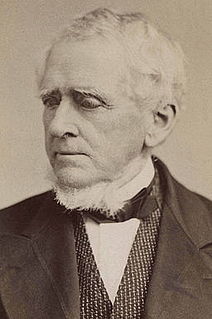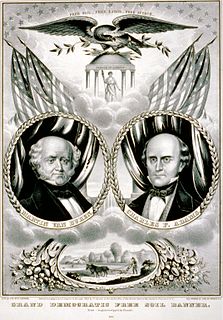
The 1848 New York state election took place on November 7, 1848 to elect the Governor, the Lieutenant Governor, a Canal Commissioner and an Inspector of State Prisons, as well as all members of the New York State Assembly.

The 1847 New York state election was held on November 2, 1847, to elect the Lieutenant Governor, the Secretary of State, the State Comptroller, the Attorney General, the State Treasurer, the State Engineer, three Canal Commissioners and three Inspectors of State Prisons, as well as all members of the New York State Assembly and the New York State Senate.

The 1849 New York state election was held on November 6, 1849, to elect the Secretary of State, the State Comptroller, the Attorney General, the State Treasurer, the State Engineer, a Judge of the New York Court of Appeals, a Canal Commissioner and an Inspector of State Prisons, as well as all members of the New York State Assembly and the New York State Senate.

The 1853 New York state election was held on November 8, 1853, to elect the Secretary of State, the State Comptroller, the Attorney General, the State Treasurer, the State Engineer, two Judges of the New York Court of Appeals, a Canal Commissioner, an Inspector of State Prisons and the Clerk of the Court of Appeals, as well as all members of the New York State Assembly and the New York State Senate.
The 1839/1840 United States Senate election in New York was held on February 5, 1839, and January 14, 1840, by the New York State Legislature to elect a U.S. Senator to represent the State of New York in the United States Senate.
The 1845 United States Senate special election in New York was held on January 18, 1845 by the New York State Legislature to elect two U.S. Senators to represent the State of New York in the United States Senate. The regular 1845 United States Senate election in New York was held on February 4, 1845, to elect a U.S. Senator to represent the State of New York in the United States Senate.
The 1849 United States Senate election in New York was held on February 6, 1849, by the New York State Legislature to elect a U.S. Senator to represent the State of New York in the United States Senate.
The 1851 United States Senate election in New York was held on February 4 and March 18/19, 1851, by the New York State Legislature to elect a U.S. Senator to represent the State of New York in the United States Senate.
The 1855 United States Senate election in New York was held on February 6, 1855, by the New York State Legislature to elect a U.S. Senator to represent the State of New York in the United States Senate.
The United States Senate elections of 1850 and 1851 were elections which had the Democratic Party lose seats, but retain a majority in the United States Senate.
The United States Senate elections of 1856 and 1857 were elections which had the young Republican Party assume its position as one of the United States's two main political parties. The Whigs and Free Soilers were gone by the time the next Congress began.
The United States Senate elections of 1854 and 1855 were elections which saw the final decline of the Whig Party and the continuing majority of the Democrats. Those Whigs in the South who were opposed to secession ran on the "Opposition Party" ticket, and were elected to a minority. Along with the Whigs, the Senate roster also included Free Soilers, Know Nothings, and a new party: the Republicans. Only five of the twenty-one Senators up for election were re-elected.
The United States Senate elections of 1844 and 1845 were elections which, coinciding with James K. Polk's election, had the Democratic Party retake control of the United States Senate, gaining a net total of eleven seats from the Whigs.

The 68th New York State Legislature, consisting of the New York State Senate and the New York State Assembly, met from January 7 to May 14, 1845, during the first year of Silas Wright's governorship, in Albany.

The 73rd New York State Legislature, consisting of the New York State Senate and the New York State Assembly, met from January 1 to April 10, 1850, during the second year of Hamilton Fish's governorship, in Albany.

The 77th New York State Legislature, consisting of the New York State Senate and the New York State Assembly, met from January 3 to April 17, 1854, during the second year of Horatio Seymour's governorship, in Albany.

The 78th New York State Legislature, consisting of the New York State Senate and the New York State Assembly, met from January 2 to April 14, 1855, during the first year of Myron H. Clark's governorship, in Albany.

The 79th New York State Legislature, consisting of the New York State Senate and the New York State Assembly, met from January 1 to April 9, 1856, during the second year of Myron H. Clark's governorship, in Albany.













